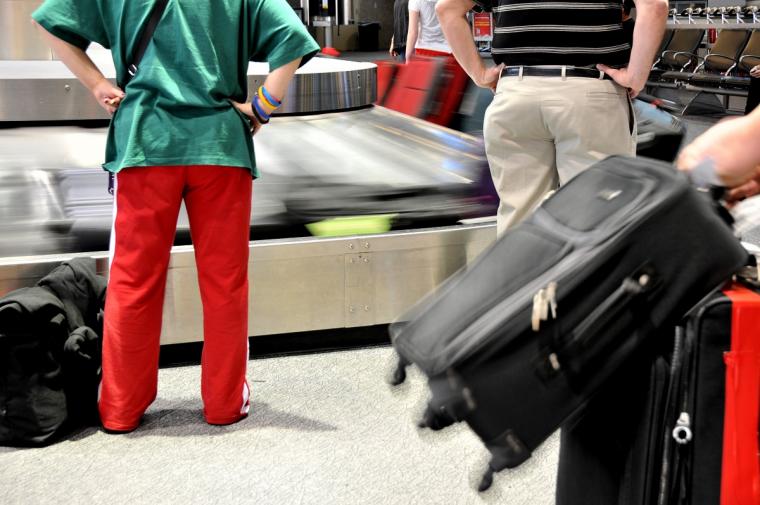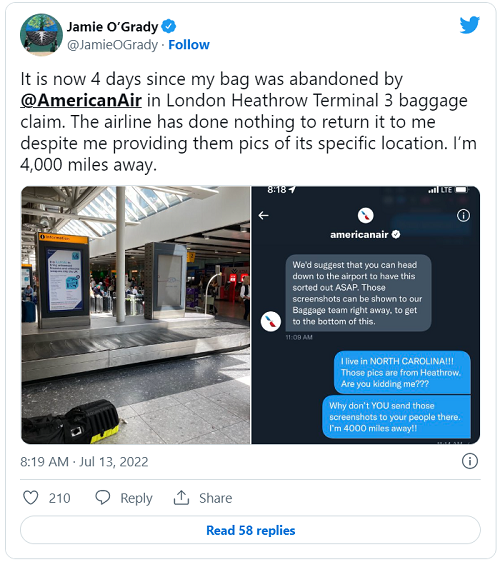
It's every traveler's nightmare and it's on the rise. Reports of bags being lost, misplaced and delayed in air travel is skyrocketing these days. In fact, the figure of (ahem) mishandled luggage is more than double of that last year.
In April, the number of bags that were at least temporarily lost by US airlines rose dramatically.
And airlines are not making it easy on passengers. The Guardian, for example, covered the issue, noting that some airlines have policies to compensate spending on replacement clothes and shoes only if the traveler’s luggage takes more than three weeks to return.
In case you didn’t read that the first time: Airlines will compensate a passenger for replacement clothes only. if. the. traveler’s. luggage. takes. more. than. three. weeks. to. return.

The problem is being called “Airmageddon.” And while policies vary from carrier to carrier, the horror stories are mounting up.
In one scenario, a US flyer tracked his lost luggage back to London and was told by American to go pick it up from the airport — even though he was 4,000 miles away in North Carolina. (Don’t miss his tweet; it went viral).
According to another article, London’s Heathrow Airport (LHR) had to beg airlines to cancel 10 percent of their flights while it dealt with a “baggage mountain” that formed as lost luggage mounted up. More than 15,000 passengers across 90 flights were affected, according to reports. The “technical failure” — which occurred at Heathrow’s Terminal 2’s handling division — led to thousands of suitcases becoming stuck in transit as staff struggled to sort them out.
Airlines are blaming baggage woes on a surge in travel, coupled with a shortage of workers, both of which are in full force this summer. The enormous uptick in cancelled and delayed flights has not helped either. In fact, almost 30,000 flights in, out and within the US were canceled this summer. The rate of baggage mishandled across the world is also on the rise: up 24 percent over last year.
Travelers don’t actually want to know the causes. They don’t care why it happened. They just want resolutions. And as sports travel hits its peak, nobody wants to lose equipment, uniforms, helmets, shoes or other items necessary for competition. That has led to more people bringing carry-on luggage; however, even that is fraught with problems since in many cases, airlines run out of overhead bin space – and need to check the bags anyway.
To try to circumvent the problem, passengers are trying creative solutions. The Guardian notes that global luggage shipping services are claiming to have seen demand almost triple month-on-month as travelers opt not to check their bags. Still other travelers report using credit cards that offer baggage delay protection, allowing them to be reimbursed if they need to buy new clothing or personal items to replace what they can't access because their luggage is missing.
Some airlines seem to be making an effort. In July, Delta flew a plane with 1,000 bags – and no passengers – from London to its hub in Detroit, in the hope of reuniting some passengers with their luggage.
The travel site, The Points Guy, meanwhile, has some suggestions to help bags stay on track – at least as much as possible. The following is taken verbatim from this article (which contains other great information, so give it a read):
Add trackers to bags
This is by far the most foolproof way of keeping track of your luggage. There are a number of trackers on the market, including LugLoc, Trakdot and, of course, Apple’s AirTags.
The trackers have some minor differing features but ultimately all do the same thing: allow you to keep track of your luggage via Bluetooth or GSM tracking technology on your phone.
While this won’t prevent your bag from being lost, it will at least help you recover your stuff once it’s misplaced.
At the very least, you won’t have to wait for all the bags to come off the carousel if you already know yours isn’t among them. A luggage tracker also enables you to tell the airline exactly where your bag is, so that it can hopefully be retrieved more easily.
Cross pack
Just like the British royal family never flies together on the same plane, you should never pack all your stuff in the same bag (unless you’re traveling alone and have no choice, of course). Share a few essentials with a travel partner so that if one person’s bag is lost, you can share the misery a little rather than one person suffering a lot.
Double label
Make sure your bag is labeled with at least two forms of identification. It’s also important to remove any old airline baggage tags, as you don’t want your bag to be accidentally re-routed to your previous destination (it can happen). It’s also smart to put some identification inside the bag as well, such as a business card.
Ribbon your bag
This is the oldest trick in the book to ensure someone else doesn’t take your bag (or you don’t take theirs) at the carousel.
If you have the generic sort of suitcase that could easily be mistaken for another (like a black wheelie case), tie a large colorful ribbon on the handle that only you will recognize. That way you will know exactly when your bag comes onto the carousel, regardless of how many other black wheelies are on the same flight.
The CEO of United, unfortunately, thinks it could take until 2023 until air travel returns to normal.
“We’re not going to get back to normal utilization and normal staffing levels until next summer,” CEO Scott Kirby said on CNBC. “The system just can’t support our flying.”
Economic uncertainty and rising fuel costs, he added, have not helped.
Of course, once you arrive at your destination (with or without your bags), you may experience yet another shortage in the travel industry: that of hotel staff. But that's an issue you can read about here.

